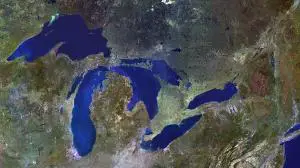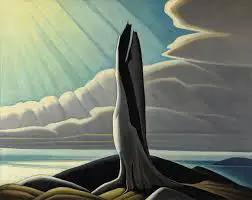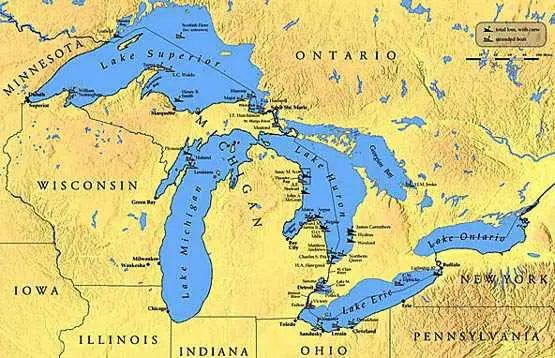Share on Social Media:
The Top 5 Largest Great Lakes
| Great Lake | Location | Area | Depth | |
|---|---|---|---|---|
| 1 | Lake Superior | Canada/USA | 82,414 sq km (31,820 sq miles) |
406 metres (1,332 feet) |
| 2 | Lake Huron | Canada/USA | 59,596 sq km (23,010 sq miles) |
229 metres (750 feet) |
| 3 | Lake Michigan | USA | 58,016 sq km (22,400 sq miles) |
282 metres (925 feet) |
| 4 | Lake Erie | Canada/USA | 25,719 sq km (9,930 sq miles) |
64 metres (210 feet) |
| 5 | Lake Ontario | Canada/USA | 19,477 sq km (7,520 sq miles) |
244 metres (802 feet) |
 Special Report
Special Report
The Great Lakes: "Great" for a Reason
The Great Lakes hold an incredible 6 quadrillion gallons of water (by recent estimates) which is about one-fifth, or 24% of the world's fresh surface water supply and nine-tenths, or an astounding 95% of the fresh water supply in the United States.The great lakes hold 84% of the fresh water (surface) on the entire continent of North America. Only the polar ice caps in the North and South poles and Lake Baikal in Siberia contain more fresh water. If the Great Lakes were spread evenly across the adjoining 48 states, the newly created "lake" water would be about 9.5 feet deep (A.)
The Great Lakes: Really, Really Big
The total area of these lakes is more than 94,000 square miles/244,000 square kilometres of water. This is larger than the states of New York, New Jersey, Connecticut, Rhode Island, Massachusetts, Vermont, and New Hampshire combined. They are sometimes referred to as "inland seas".Combined, the Great Lakes span more than 750 miles or 1,200 kilometers from west to east, and there are more than 30 million people living close to their shores. That's almost the whole population of Canada.
The Great Lakes have a total of 17,549 kms of coastline (including connecting channels, mainland and islands). The Great Lakes shoreline is equal to almost 44 percent of the circumference of the earth. (A.)

Lake Superior is Pretty Superior
Lake Superior is called "superior" not because it's the largest Great Lake but because it is higher upstream than the others but having said that, it is also the biggest and deepest and overall superior-est. It also has enough water to fill all the other great lakes combined. At low-water Lake Superior has an amazing 2,900 cubic miles of water (12,087 cubic kilometres). It has a maximum depth of 1,332 feet (405 metres).The deepest lake in North America is Great Slave lake in the Northwest Territories in Canada at 2,015 feet deep (614 metres), so comparatively our Lake Superior is pretty respectable depth-wise. By the way, the deepest lake in the world is lake Baikal in Russia at over 5,000 feet deep. Lake Superior may not come close to that but it truly is the greatest of the great lakes. (A.)

The Other Great Lakes: Great yes, but not Superior
Lake Huron, the next largest great lake, was discovered by the French and was called "La Mer Douce" or the "Sweet Sea" (sweet meaning fresh water). On later maps it became known as "Lac des Hurons" which means Lake of the Huron Indians. Lake Huron has the most shoreline length of all the great lakes at 3,827 miles or 6,159 kilometres (including islands).Sorry Canadians, Lake Michigan is the only great lake that is entirely in one country: The United States.

Lake Erie comes from "Eries", a tribe of Indians. This name is always mentioned by the early French writers as meaning "cat"; Lac du Chat means "Lake of the Cat." Lake Michigan has had many names, among them: "Lake of the Stinking Water", "Lake of the Puants," "Lac des Illinois", "Lac St. Joseph", and also "Lac Dauphin" One indian name for Lake Michigan was "Michi gami." Champlain first called Lake Ontario "Lake St. Louis". In 1660, Franciscus Creuxius a map maker, gave it the name Lacus Ontarius. Ontara in Iroquois means "lake," and Ontario, "beautiful lake."
The Great Lakes are an Economic Powerhouse between Canada and the USA
The GDP of the Great Lakes area is estimated to be around $6 trillion USD. That's a lot of cash. In fact, in terms of GDP, it would be the third largest country in the world if the Great Lakes were a country. Trade in the Great Lakes area with Canada accounts for more than 50% of all U.S./Canadian bilateral border trade, and since Canada is the US's largest trading partner by FAR (surprise Americans!), that amounts to around $278 billion dollars worth of trade between the US and Canada annually within the Great Lakes region alone.In fact, and this will blow your mind Americans, more trade is done over the Ambassador bridge (to Canada) in Michigan alone than the trade done with France Germany, South Korea, and Great Britain all together (surprise again Americans)! Just one bridge connecting the United States and Canada is a link to all that trade, commerce, jobs and cash. Amazing, and a fact that most people are unaware of. (B.)

Do NOT Underestimate the Importance of the Great Lakes
Historically, the Great Lakes have been very important in the economic development and sustainability of the United States and Canada. Anywhere from 30 to 40 million people in the U.S. and Canada depend on the Great Lakes for fresh drinking water and for economic development. To begin with, the water from the great lakes supports 7% of the agricultural production of the United States and 25% of Canadian agriculture so they are extremely important for growing food too.We could write a lot about how important The Great Lakes really are, but let's just say they are extremely important for shipping and transportation, agriculture, tourism, recreation, fisheries and, of course, as a source of drinking water. The Great Lakes supply 25% of Canada's drinking water and over 10% of the drinking water in the United States.
The great Lakes are also important to a huge variety of water and land life and their ecosystems. They are home to an estimated 177 species of fish alone, not to mention all the plants, birds, insects, mammals, and molluscs (nobody ever thinks about the molluscs). Naturally, we as humans in general are messing the Great Lakes up. A lot of those species are threatened by invasive species, climate change, land development and pollution.
Top 5 Special Report Sources
A. United States Environmental Protection Agency. (2020). "Facts and Figures about the Great Lakes."
B. Desjardins, J. (2016). Visual Capitalist.com: The Great Lakes Economy: The Growth Engine of North America
Tags:
Planet Earth, Water, Top 5 Largest
Sources: Top5ofanything.com Great Lakes Research 2020: Including: United States Environmental Protection Agency
List Notes: Data is the top 5 largest great lakes ranked according to square kilometres. The Great Lakes are a group of five freshwater lakes located in North America and boarder the United States and Canada.
Sources: Top5ofanything.com Great Lakes Research 2020: Including: United States Environmental Protection Agency
List Notes: Data is the top 5 largest great lakes ranked according to square kilometres. The Great Lakes are a group of five freshwater lakes located in North America and boarder the United States and Canada.

